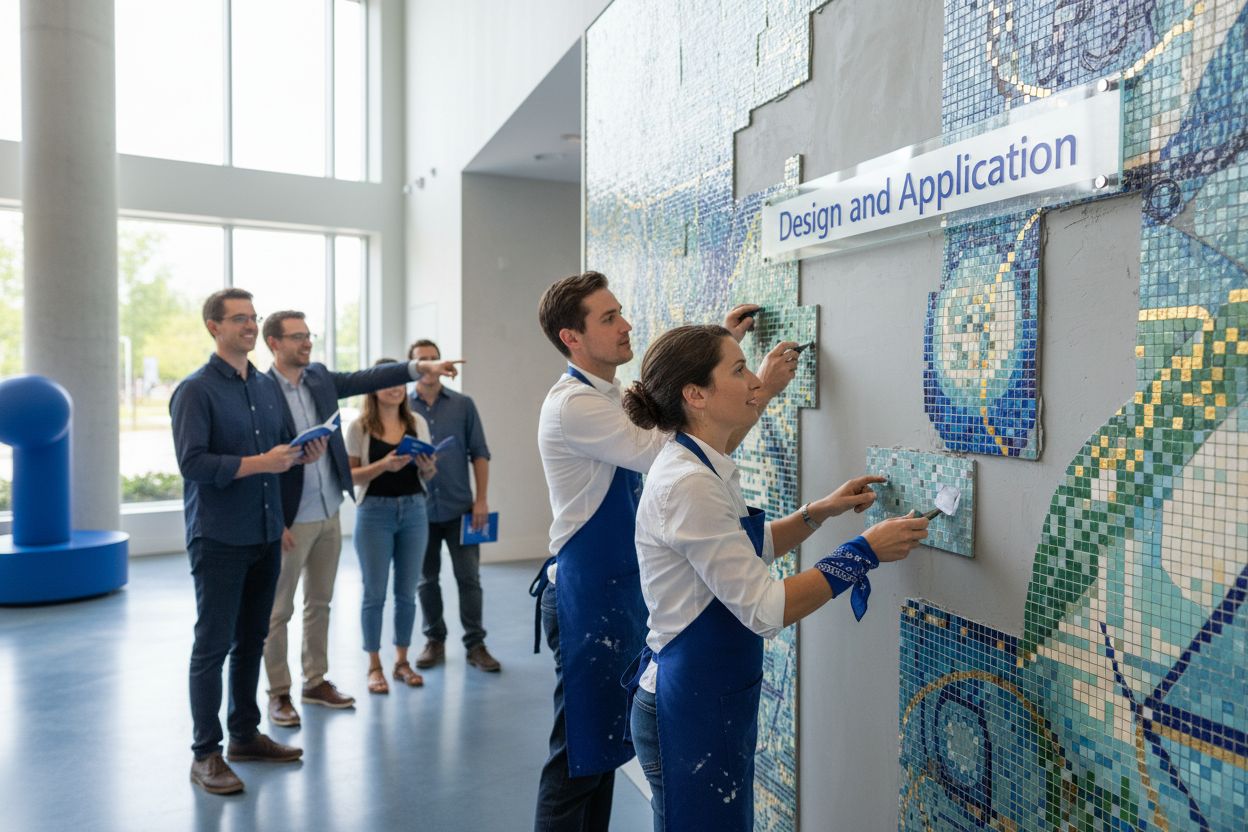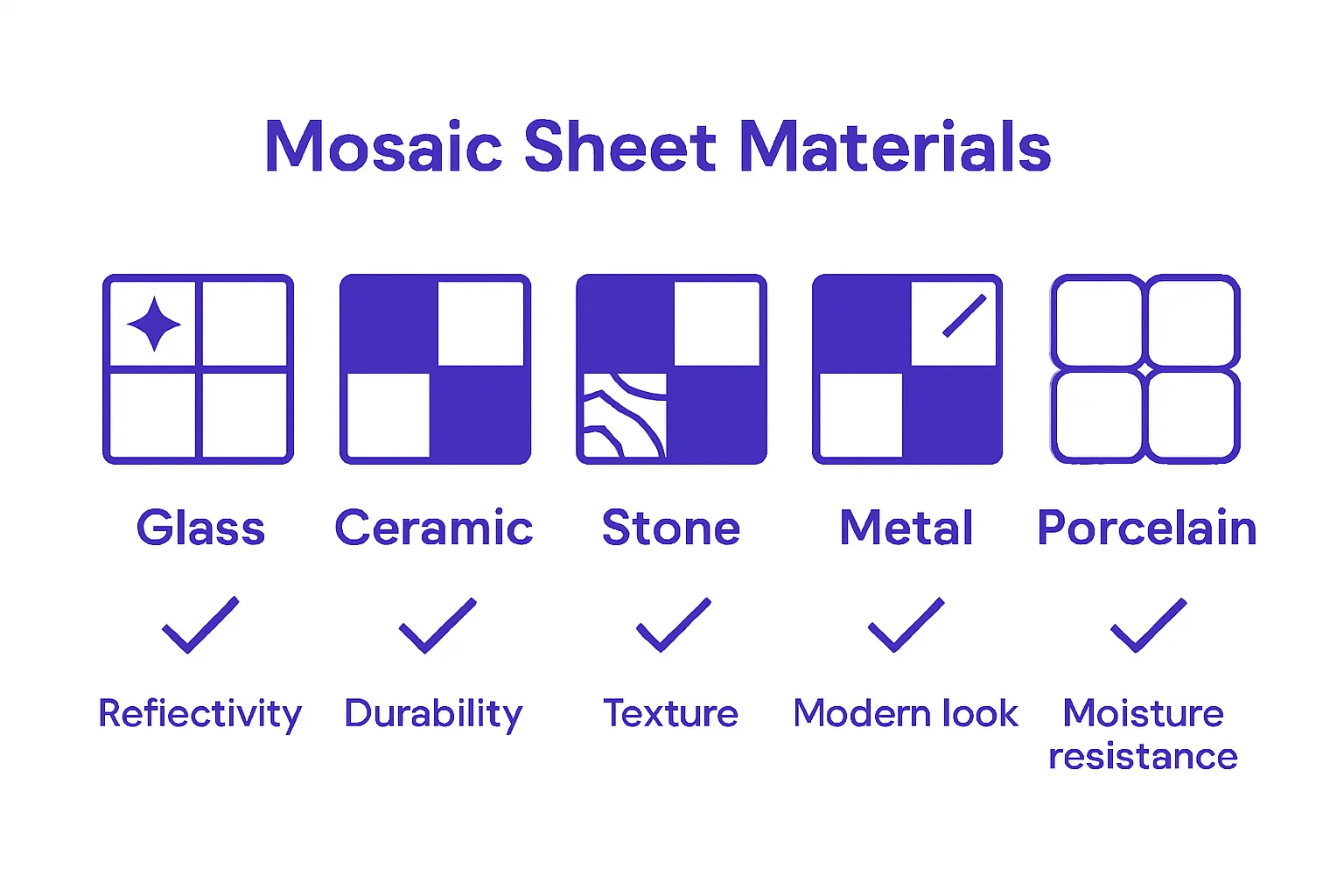Understanding What is Mosaic Sheet: An In-Depth Guide
Posted by Mike Belk on Oct 05, 2025

Mosaic sheets are shaking up interior design in a huge way and not just because they look stunning on a backsplash or bathroom wall. Some mosaic sheets use over 500 tiny tile pieces per square foot to create their detailed patterns. Most people think all those little tiles make installation a nightmare. The truth is they actually make it much faster and easier than old fashioned methods where every tile had to be placed by hand.
Table of Contents
- Defining Mosaic Sheets: The Basics
- The Importance Of Mosaic Sheets In Design And Architecture
- How Mosaic Sheets Are Made: Materials And Techniques
- Practical Applications Of Mosaic Sheets In Homes And Businesses
- Choosing The Right Mosaic Sheet: Key Factors To Consider
Quick Summary
| Takeaway | Explanation |
|---|---|
| Mosaic sheets offer versatile design solutions. | They can be used in various applications like backsplashes and accent walls, enhancing aesthetic appeal. |
| Material selection impacts durability and style. | Choosing the right material affects the visual design and maintenance needs of the mosaic sheets. |
| Mosaic sheets simplify installation. | Their pre-arranged formats and mesh backing allow for quicker installation compared to traditional tiles. |
| Consider performance factors for best results. | Evaluate moisture resistance and slip coefficient based on the intended installation environment. |
| Mosaic sheets enhance both aesthetics and function. | They combine beauty with practical properties, making them suitable for high-traffic commercial spaces as well. |
Defining Mosaic Sheets: The Basics
Mosaic sheets represent a sophisticated tile solution that transforms interior and exterior design spaces with intricate, pre-arranged tile configurations. Mosaic sheets are specialized tile assemblies that combine multiple small tiles (called tesserae) mounted on a mesh or backing material, creating seamless and visually compelling surface coverings.
Understanding Mosaic Sheet Composition
The fundamental structure of mosaic sheets involves carefully arranged tile pieces mounted on a flexible backing, typically made of fiberglass mesh or paper. This innovative design offers several critical advantages:
- Enables uniform installation across larger surface areas
- Allows complex patterns to be implemented quickly
- Provides consistent spacing between individual tile pieces
Mosaic sheets can incorporate diverse materials including glass, ceramic, stone, and metal, offering remarkable design versatility. The mesh backing ensures that intricate designs remain intact during transportation and installation, making them significantly easier to apply compared to individual tile placement.
Design and Application Versatility
These versatile design elements are not confined to a single aesthetic or functional purpose. Homeowners and designers can utilize mosaic sheets in numerous applications such as kitchen backsplashes, bathroom walls, swimming pool accents, and decorative feature walls. Read more about creative mosaic tile applications to understand their transformative potential.
The modular nature of mosaic sheets allows for remarkable design flexibility. Whether you prefer geometric patterns, natural stone appearances, or vibrant color transitions, mosaic sheets provide an accessible pathway to achieving sophisticated design outcomes without requiring extensive technical expertise.
The Importance of Mosaic Sheets in Design and Architecture
Mosaic sheets have emerged as a transformative element in contemporary design and architectural practices, bridging aesthetic innovation with functional sophistication. Architectural design increasingly recognizes mosaic sheets as a powerful medium for creating visually compelling and structurally integrated surfaces.
Aesthetic and Functional Significance
Beyond mere decorative elements, mosaic sheets represent a strategic design tool that offers unparalleled design flexibility. Architects and interior designers leverage these versatile surfaces to:
- Create seamless visual narratives across different spaces
- Introduce complex textural dimensions without extensive manual labor
- Achieve precise color and pattern transitions
The intricate nature of mosaic sheets allows designers to transform ordinary surfaces into extraordinary visual experiences, whether in residential, commercial, or public architectural contexts.
Technological and Creative Convergence
Mosaic sheets exemplify the intersection of technological manufacturing and creative expression. Explore innovative mosaic tile applications that demonstrate how these design elements transcend traditional decorative boundaries. The precision engineering behind mosaic sheet production enables architects to implement highly detailed design concepts with remarkable consistency and efficiency.
From minimalist contemporary spaces to ornate traditional environments, mosaic sheets provide a versatile design language that can communicate complex aesthetic narratives while maintaining structural integrity and visual elegance. Their ability to adapt to various architectural styles makes them an indispensable tool in modern design strategies.
How Mosaic Sheets are Made: Materials and Techniques
The production of mosaic sheets is a sophisticated process that combines artistic precision with advanced manufacturing technologies. Manufacturing techniques for mosaic sheets involve intricate steps that transform raw materials into seamless, visually stunning design elements.
Material Selection and Preparation
The foundation of quality mosaic sheets begins with meticulous material selection. Manufacturers typically utilize a diverse range of materials including:
- High grade glass
- Natural stone fragments
- Ceramic tiles
- Metallic elements
- Porcelain components
Each material undergoes rigorous processing to ensure uniform size, shape, and color consistency. The precise cutting and shaping of individual tesserae require specialized equipment that can create minute pieces with exceptional accuracy.
Mounting and Assembly Techniques
The critical phase of mosaic sheet production involves mounting individual tiles onto a backing material. Learn more about intricate tile installation methods that showcase the complexity of this process. Most manufacturers use fiberglass mesh or specialized adhesive paper as the primary mounting substrate, which ensures:
- Consistent tile spacing
- Structural integrity during transportation
- Easy installation for end users
Advanced manufacturing processes now incorporate computer aided design technologies that allow for unprecedented pattern precision and complexity, transforming mosaic sheets from traditional handicraft to a modern design solution with remarkable engineering sophistication.
Practical Applications of Mosaic Sheets in Homes and Businesses
Mosaic sheets have transcended traditional decorative boundaries, emerging as versatile solutions for diverse architectural and design challenges. Contemporary design practices demonstrate the remarkable adaptability of these intricate tile assemblies across residential and commercial environments.
Residential Design Innovations
Homeowners increasingly recognize mosaic sheets as powerful design elements that transform ordinary spaces into extraordinary experiences. These versatile surfaces find exceptional utility in:
- Kitchen backsplashes
- Bathroom wall treatments
- Shower enclosures
- Fireplace surrounds
- Accent wall features
The modular nature of mosaic sheets allows for personalized design expressions that reflect individual aesthetic preferences while maintaining practical durability. Their ability to introduce complex visual textures makes them an ideal choice for spaces demanding both style and functionality.
Commercial and Public Space Applications
Explore innovative tile applications for commercial spaces that showcase their expansive potential. Beyond residential settings, mosaic sheets play crucial roles in commercial environments such as:
- Hotel lobby designs
- Restaurant feature walls
- Corporate office reception areas
- Retail store displays
- Healthcare facility accent spaces
The precision and versatility of mosaic sheets enable designers to create immersive environments that communicate brand identity, aesthetic sophistication, and architectural innovation. Their durability and ease of maintenance make them particularly attractive for high traffic areas requiring both visual impact and practical performance.

Choosing the Right Mosaic Sheet: Key Factors to Consider
Selecting the perfect mosaic sheet requires a strategic approach that balances aesthetic preferences with practical performance requirements. Mosaic tile selection involves multiple critical considerations that extend far beyond simple visual appeal.
Material Composition and Durability
The fundamental starting point in mosaic sheet selection involves understanding material characteristics. Different materials offer unique advantages:
- Glass: Provides luminous reflective qualities
- Ceramic: Offers exceptional durability
- Natural stone: Delivers organic textural variations
- Metal: Creates contemporary industrial aesthetics
- Porcelain: Ensures high moisture resistance
Each material demands specific maintenance protocols and exhibits distinct performance attributes in varying environmental conditions.
Here is a breakdown of the primary materials used in mosaic sheets and their key characteristics to help you match them with your design and performance needs.
| Material | Key Characteristics | Common Applications |
|---|---|---|
| Glass | Luminous, reflective, water-resistant | Backsplashes, bathrooms, pools |
| Ceramic | Durable, versatile, easy to maintain | Kitchen walls, showers |
| Natural Stone | Organic texture, unique variation | Accent walls, fireplace surrounds |
| Metal | Contemporary, industrial, sleek look | Feature walls, modern designs |
| Porcelain | High moisture resistance, strong | Wet areas, high-traffic floors |
 Homeowners and designers must carefully evaluate the intended installation space to match material properties with functional requirements.
Homeowners and designers must carefully evaluate the intended installation space to match material properties with functional requirements.
Performance and Environmental Considerations
Explore advanced features in specialty mosaic selections that enhance design versatility. Critical performance factors include moisture resistance, slip coefficient, thermal stability, and load-bearing capacity. Professional designers recommend thoroughly assessing environmental conditions such as temperature fluctuations, humidity levels, and potential mechanical stress before finalizing mosaic sheet selections. The backing material quality equally influences long term performance, with fiberglass mesh and specialized adhesive substrates offering superior installation reliability and structural integrity.
Bring Your Mosaic Vision to Life with BELK Tile Solutions
After exploring what mosaic sheets are and how they revolutionize interior and exterior spaces, you might be facing the same challenge many readers do: achieving the perfect balance of design flexibility, material quality, and reliable installation for your project. Whether you’re struggling with selecting the right material for your bathroom wall, worried about complex installation, or want a unique color combination for your kitchen backsplash, the search for the right products and inspiration can feel overwhelming. BELK Tile understands the importance of seamless patterns, easy installation, and the ability to match your exact style needs—all concepts explored in this guide.
Ready to transform your space with professionally crafted mosaic sheets? Visit BELK Tile’s online store and browse a handpicked collection of glass, ceramic, stone, and specialty mosaic tiles designed for durability and elegance. For more inspiration and ideas on how to elevate your next project, start with our main page at https://www.belktile.com and see how our easy navigation and advanced filtering can simplify your selection process. Take the first step today and let BELK Tile help you achieve the beautiful, long-lasting results you want—before popular styles run out.
Frequently Asked Questions
What are mosaic sheets made of?
Mosaic sheets are typically composed of a variety of materials, including glass, ceramic, natural stone, and metal. These materials are carefully arranged into small pieces called tesserae, which are then mounted on a flexible backing, usually made of fiberglass mesh or paper.
How are mosaic sheets installed?
Mosaic sheets are designed for easy installation thanks to their pre-arranged tile configurations. The mesh backing allows for consistent spacing between tiles, enabling uniform application across larger surfaces, thus simplifying the installation process compared to placing individual tiles.
What are the advantages of using mosaic sheets over traditional tiles?
Mosaic sheets offer several advantages, including quicker installation, complex pattern implementation without extensive technical skills, and the ability to create seamless designs more efficiently. They provide a versatile design solution suitable for various applications in both residential and commercial spaces.
Can mosaic sheets be used in wet areas like bathrooms and swimming pools?
Yes, mosaic sheets are suitable for wet areas such as bathrooms and swimming pools, especially when made from water-resistant materials like glass or porcelain. They can enhance both the aesthetic appeal and functionality of spaces prone to moisture.



